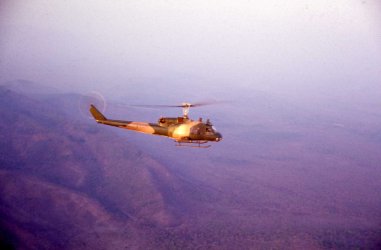I flew
Green Hornet Helicopter gunships in
Daniel Boone 
To supply their forces in South Vietnam, the North Vietnamese built a secret road system through neutral Laos and Cambodia. This supply line, named the Truong Son Road but called the "Ho Chi Minh Trail" by Americans, consisted of a network of roads and hiding places concealed by jungle. In an effort to stop the communists' flow of supplies while appearing to respect Laotian and Cambodian neutrality, the United States secretly placed radar stations to guide air strikes and sent small reconnaissance teams of native personnel into Laos and Cambodia. Led by U.S. Army Special Forces personnel, those reconnaissance teams found targets for airstrikes and later assessed the damage. These cross-border or "over the fence" operations relied upon U.S. Air Force helicopters for transportation and resupply.
Covert reconnaissance operations into Laos, code named SHINING BRASS and later PRAIRIE FIRE, began in1965. Using the call sign Pony Express, Sikorsky CH-3 Jolly Green Giant helicopters from the 20th Helicopter Squadron (later re-designated the 20th Special Operations Squadron) operated from Nakhon Phanom Royal Thai Air Force Base in support of these secret missions and the radar sites. Later, the squadron received BellUH-1F/P "Huey" helicopters to support the effort. The20th's mission expanded as they started working closely with forward air controllers and other USAF aircraft in Laos to rescue downed American pilots.
In 1967 the U.S. expanded its secret reconnaissance operations into Cambodia under the code names
DANIEL BOONE and later SALEM HOUSE. The 20th's UH-1s supported these operations using the call sign
Green Hornet. During a Green Hornet mission on Nov. 26, 1968, Capt. James P. Fleming earned the Medal of Honor while rescuing a six-man reconnaissance team.
The group rescued was code named "RT Chisel," and it was composed of Staff Sergeant Ancil "Sonny" Franks, Sergeant Charles Hughes, three Montagnards, and Captain Randolph Harrison (he was the new CCS Recon Company commander and there to learn ops). The Americans were SOG personnel (Green Berets) while the Montagnards were indigenous personnel that worked with SOG. All six were safely recovered during the operation.
The 20th's SikorskyCH-3 Jolly Green Giant helicopters were separated into the 21stHelicopter Squadron (later re-designated the 21st Special Operations Squadron) in 1967. The 21st continued supporting the covert operations in Laos, including the placement of IGLOO WHITE electronic sensors, from Nakhon Phanom under the call sign of Dust Devils.
To insert and resupply covert reconnaissance teams deep into North Vietnam, the USAF used special Lockheed C-130E(I) aircraft. Later redesignated the MC-130E Combat Talon I, this aircraft was equipped with the Fulton Recovery System to pick up personnel and packages.This system used a balloon to suspend a cable which the MC-130E would snag in flight. At first using the innocuous designation Detachment1, 314th Tactical Airlift Wing (later the 15th Special Operations Squadron), they operated from Nha Trang Air Base, Republic of Vietnam. Nicknamed "Blackbirds" because of their special green and black paint scheme, these MC-130Es avoided enemy detection by using terrain-following radar to fly very low at night.
While these secret missions never stopped the flow of supplies to the communists in the south,
they caused severe disruptions. In addition,the need to defend against these reconnaissance teams caused the North Vietnamese to hold back troops that could have been fighting in South Vietnam.

